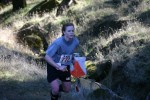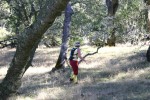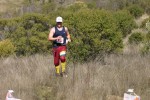| Table of contents |
Pace Counting
by
As part of the training events sponsored by Western Connecticut O Club (WCOC) on Oct. 31, 2000, Tony Federer gave a workshop on pace counting. I found his approach to pace counting very valuable and the following is a short summary of it.
A pace is generally measured by two steps - i.e., you count one pace every time your left foot hits the ground. A pace count is the number of paces per 100 meters. He uses only one pace count figure, the average number of paces you take at your normal pace through average vegetation in average terrain. If the vegetation is thick, or the hill is steep, then periodically he puts in a 3-step pace instead of a 2-step pace. If the running is fast, such as on a trail going downhill, he expects the end point to arrive before his pace count. If you don't know what your average pace is, then start out with 55 paces per 100 meters, and adjust from there.
Making a Map Scale
The most important aspect of his approach is to make a scale, marked out in paces, that you tape onto the edge of the compass. Then it is possible to lay the compass on the map, and look directly at the scale to determine how many paces (as opposed to meters) the end point is. He feels it's important to have the scale in paces, so you don't have to do the mathematical conversion every time you want to determine how many paces away a feature is. This mental calculation gets more difficult at the end of an event when you are tired, or if the map uses some unusual scale like 1:7500.
To make the scale, take a small piece of tape such as masking tape or adhesive tape about 3 to 4 cm long and 2 cm wide. (Duct tape does not work very well, because it is shiny, and hard to see the markings.) Carefully place one end of the tape at the tip of the edge of the compass and line up the tape so its edge is parallel with the edge of the compass. Put the tape on so that the middle of the tape is on the edge of the compass, and then one side is folded around on the front of the compass, and the other side is folded onto the back side of the compass. The tape will then be wrapped around the edge of the compass. If you use a thumb compass, put it over the pre-marked scale on the right hand edge. If you use a base plate compass, put it on the left edge. You now have a strip of tape on the front edge of the compass that measures about 1 cm wide and 3 to 4 cm long.
Now you will use a ballpoint pen to make tic marks on the tape to indicate the scale. There will be a major tic mark every 50 paces, and smaller intervening tic marks indicating every 10 paces. First, make the major tic marks. Lay the compass down on the scale of the map that you will be using. If your pace count was 50 paces per 100 meters, then you would make your major tic mark every 100 meters. However, if your pace count is 55 paces per 100 meters, you will have covered 90 meters for 50 paces (50/55=0.9). Therefore, make the tic mark at about 90 meters (90% of the 100-meter mark on the map scale) for the first major tic mark, indicating 50 paces. You can just eyeball this, as it does not have to be that precise. Then move the compass so that the first tic is now at 0 and make the second tic at the 90-meter mark (90% of the 100-meter mark on the map scale). Move the compass again so that the second tic is now at 0 and make the third tic at 90 meters. If you do not want to move the compass, you can make the marks at 90 meters, 180 meters, 270 meters, etc. Label these tic marks as 50, 100, 150, etc.
Use the following conversions for different pace counts:
| Pace count per 100 meters | Number of meters on map scale for 50 paces | Mm betwwen major tick marks for 1:10,000 scale |
|---|---|---|
| 45 | 110 | 11 mm |
| 50 | 100 | 10 mm |
| 55 | 90 | 9 mm |
| 60 | 83 | 8 mm |
Then make 4 equidistant marks on the tape between each major tic mark. Again, it doesn't have to be that precise. Each one of these marks will then represent 10 paces. Mark on the edge of the tape the scale of map (e.g. 1:10 or 1:15) and the pace count (e.g. 55). You do not have to change the tape scale if the map scale of the next event is the same. However, if the map scale changes, then you will have to make up a new tape scale for that event.
Determining Your Pace Count
To calibrate your pace count, make a simple course on a map using short legs (less than 200 meters) with major features and each of which you can run in a reasonably straight line. Use a variety of legs, including cross-country, trail runs, uphill, downhill, open areas, and thicker terrain.
Using the pace scale on your compass, measure out how many paces you expect to take for each leg. Round up or down to the nearest 5 paces. Write these numbers down.
Then run the first leg, going at your normal race pace, and write down the number of paces it took you for that leg. Repeat each leg, writing down the actual number of paces you took next to your pre-measured count.
Hopefully, you pre-measured count will be about right, with some legs being a little short, and the others a little long. However, if you consistently took more paces or fewer paces that predicted, re-make your pace scale so that it is correct.
Using Pace Counting
When should you use pace counting? This is a controversial topic, and opinions vary widely. Some orienteers use it all the time, some use it occasionally, and some never use it. Tony uses it all of the time, and feels it is one more tool that he can use to help him navigate successfully. It has just become second nature to him, and he always has a pace count going. He also says that in order to get good at it, you have to practice it, and therefore it is better if you use it all the time.
How far away should your end point be? He feels that the distance should never be more than 200 meters away, and he restarts his count at every major feature or checkpoint along his route that he is absolutely sure he is at. Thus, if he comes to a trail crossing, major reentrant, big rock feature, or other significant feature that he is sure of, he restarts his pace count. However, if he is unsure, he keeps his original count going. If he overshoots a point, then he starts subtracting counts on his way back. This is a time when you need your pace count most, and so he feels it is important to keep the count as accurate as possible.
I found this approach to be very helpful, particularly with the use of a pace count scale on the compass. I always had a lot of problems making the mental conversions from meters to paces, and this simplifies using pace counting immensely.
[Back to Training]




